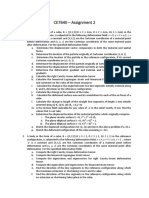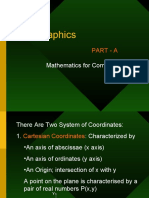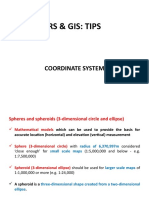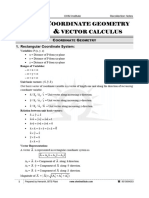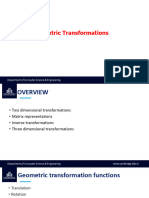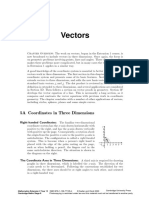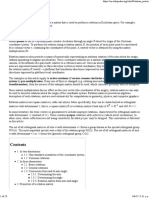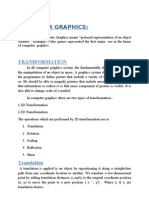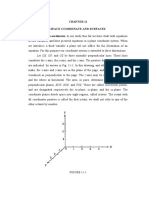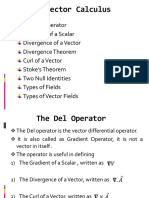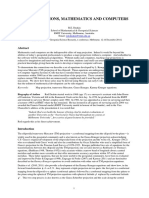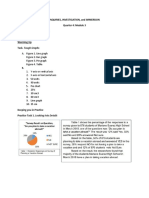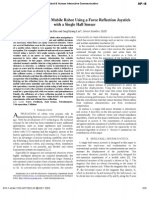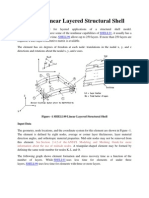Coordinate Transformations in Surveying and Mapping: Geospatial Science Rmit
Coordinate Transformations in Surveying and Mapping: Geospatial Science Rmit
Uploaded by
ulastuna2001Copyright:
Available Formats
Coordinate Transformations in Surveying and Mapping: Geospatial Science Rmit
Coordinate Transformations in Surveying and Mapping: Geospatial Science Rmit
Uploaded by
ulastuna2001Original Title
Copyright
Available Formats
Share this document
Did you find this document useful?
Is this content inappropriate?
Copyright:
Available Formats
Coordinate Transformations in Surveying and Mapping: Geospatial Science Rmit
Coordinate Transformations in Surveying and Mapping: Geospatial Science Rmit
Uploaded by
ulastuna2001Copyright:
Available Formats
Geospatial Science RMIT
COORDINATE TRANSFORMATIONS
IN SURVEYING AND MAPPING
R.E.Deakin July 2004
Coordinate transformations are used in surveying and mapping to transform coordinates in one
"system" to coordinates in another system, and take many forms. For example
• Map projections are transformations of geographical coordinates, latitude φ and longitude λ on
a sphere or ellipsoid, to rectangular (or Cartesian) coordinates on a plane.
• Polar–Rectangular conversions where coordinates of points in polar coordinates, say bearings
and distances, are converted to rectangular coordinates.
• Two-Dimensional (2D) transformations where the coordinates of points in one rectangular
system (x,y) are transformed into coordinates in another rectangular system (X,Y).
• Three-Dimensional (3D) transformations where coordinates of points in one right-handed
rectangular system (x,y,z) are transformed into another rectangular system (X,Y,Z).
3D transformations also include transformations from geographical coordinates ( φ , λ ) on a
reference surface (sphere or ellipsoid), to rectangular coordinates (X,Y,Z) whose origin is at the
centre of the reference surface, or to a local rectangular system (E,N,U) whose origin is a point on
the reference surface.
The effect of a transformation on a group of points defining a 2D polygon or 3D object varies from
simple changes of location and orientation (without any change in shape or size), to uniform scale
change (no change in shape), and, finally, to changes in shape and size of different degrees of non-
linearity (Mikhail 1976).
© 2004, R.E.Deakin Coordinate Transformations 2004 1–1
Geospatial Science RMIT
In general we consider points in space as being connected to the origin O of a 3D right-handed
rectangular coordinate system X,Y,Z. Such a system can be visualised as the corner of a room
where the intersection of two walls and the floor provide three reference lines OX, OY and OZ,
known as the X-, Y- and Z-axes that are (usually) at right angles to one another. The X-Z and Y-Z
planes are the walls and the X-Y plane is the floor.
Z
The three mutually perpendicular axes X, Y and Z are
related by the right-hand rule as follows:
If the thumb, the forefinger and the second finger of
X the right hand are placed mutually at right angles then
the thumb points in the Z-direction, the forefinger
points in the X-direction and the second finger points
in the Y-direction.
Z The axes X, Y and Z (in the cyclic order XYZ) are a
right-handed system (or dextral system) since a
rotation from X towards Y advances a right-handed
screw in the direction of Z. Similarly, a rotation
from Y towards Z advances a right-handed screw in
the direction of X and so on. The diagram on the left
shows the right-hand screw rule for the positive
Y
directions of rotations and axes of a right-handed
θ rectangular coordinate system. These rotations are
considered positive anticlockwise when looking
X along the axis towards the origin; the positive sense
of rotation being determined by the right-hand-grip
rule where an imaginary right hand grips the axis with the thumb pointing in the positive direction
of the axis and the natural curl of the fingers indicating the positive direction of rotation. In the
following pages, transformations in two-dimensional (2D) space are discussed: in such cases points
are considered to have only X,Y coordinates, i.e., they lie in the X-Y plane with a Z-value = 0.
1. TRANSFORMATIONS IN TWO-DIMENSIONAL (2D) SPACE
© 2004, R.E.Deakin Coordinate Transformations 2004 1–2
Geospatial Science RMIT
In 2D transformations all points lie in a plane. In these notes it is assumed that 2D transformations
are transformations from one rectangular coordinate system (u,v) to another rectangular system
(x,y). In addition, unless stated otherwise, a rotation is an angle considered to be positive in an
anticlockwise direction as determined by the right-hand-grip rule. This is consistent with
mathematics, where angles are measured positive anticlockwise from the x-axis and also in
applications in Photogrammetry and Remote Sensing.
1.1. Transformations involving Rotation only
u,v coordinates are transformed to x,y coordinates by considering a rotation of the u,v coordinate
axes through a positive anticlockwise angle θ . The transformation equations can be expressed in
the following way
x = u cos θ + v sin θ
(1.1)
y = − u sin θ + v cos θ
or in matrix notation
x cos θ sin θ u
y = − sin θ cosθ v
(1.2)
As an example consider the polygon ABCD whose u,v coordinates are rotated by a positive
anticlockwise angle θ = 30D . Figure 1 shows the initial location of the polygon in the u,v system
and Figure 2 shows its transformed (rotated) location in the x,y system.
v B
y C Point u v
A 100.000 250.000
A x
B 200.000 423.205
C 286.602 373.205
D D 157.735 150.000
Figure 1 Polygon ABCD with u,v coordinates in metres
© 2004, R.E.Deakin Coordinate Transformations 2004 1–3
Geospatial Science RMIT
y Point x y
B
A 211.603 166.506
A C B 384.808 266.506
C 434.807 179.904
D 211.603 51.036
D
x
Figure 2 Rotated polygon ABCD with x,y coordinates in metres
Comparing Figures 1 and 2 it appears that the size and shape of the polygon ABCD has not changed
but its orientation with respect to the coordinate axes has. This can be verified by considering the
dimensions (bearings and distances) of the polygon ABCD derived from the two coordinate sets.
Line Bearing Distance Line Bearing Distance
AB 30D 00′ 200.000 AB 60D 00′ 200.000
BC 120D 00′ 100.000 BC 150D 00′ 100.000
CD 210D 00′ 257.735 CD 240D 00′ 257.735
DA 330D 00′ 115.470 DA 0D 00′ 115.470
Polygon dimensions in the u,v system Polygon dimensions in the x,y system
This example demonstrates that a rotation of the coordinate axes causes an apparent rotation, in an
opposite direction, of any polygon defined within the coordinate system. The size and shape of the
polygon does not change.
© 2004, R.E.Deakin Coordinate Transformations 2004 1–4
Geospatial Science RMIT
Equation (1.1) and its matrix equivalent (1.2) can be obtained by considering Figure 3.
y P
u
θ ·
v sin
θ
os
uc x
us
v
in θ
vc
os
θ
θ
u
Figure 3 x,y coordinates of P as functions of u,v coordinates and rotation θ
1.1.1. Rotation matrices
Equation (1.2) can be expressed as
x cos θ sin θ u u
y = − sin θ
cosθ v = R (1.3)
v
cos θ sin θ
where R = is known as a rotation matrix. Rotation matrices are orthogonal, i.e.,
− sin θ cos θ
the sum of squares of the elements of any row or column is equal to unity and an orthogonal matrix
has the unique property that its inverse is equal to its transpose, i.e., R −1 = R T . This useful
property allows us to write the transformation from x,y coordinates to u,v coordinates as follows.
x u
y = R v
x u
R −1 = R −1R
y v
x u
RT = I
y v
and rearranging gives
© 2004, R.E.Deakin Coordinate Transformations 2004 1–5
Geospatial Science RMIT
u x cos θ − sin θ x
v = R y = sin θ
T
(1.4)
cosθ y
We could write (1.4) as
u cos θ − sin θ x x
v = sin θ = R∗
cosθ y y
which in words means: the x,y coordinates are transformed (rotated) to u,v coordinates. Equation
(1.3) on the other hand means: the u,v coordinates are transformed (rotated) to x,y coordinates and it
is interesting to note that R and R ∗ are in fact the same rotation matrix except in the former, θ is
positive anticlockwise and in the latter θ is positive clockwise. Note that sin( −θ ) = − sin θ and
cos( −θ ) = cos θ .
1.1.2. Orthogonal Matrices
Orthogonal matrices are extremely useful since their inverse is equal to their transpose. Rotation
matrices R are orthogonal, hence R −1 = R T . A proof of this can be found in Allan (1997) and is
repeated here.
Consider the effect of a rotation on the coordinates x of a point P, expressed as
X = Rx
X is the transformed (or rotated) coordinates and R is the rotation matrix. Multiplying both sides of
the equation by the inverse of R gives
R −1X = R −1Rx
but from matrix algebra R −1R = I and Ix = x so
R −1X = x
or x = R −1X
The length (actually squared length) of the line from the origin to the original position of point P is
given by x T x and the length from the origin to the new (rotated) position is given by X T X . This
length does not change due to rotation, i.e., it is invariant under rotation. Hence
xT x = X T X
but X = Rx
© 2004, R.E.Deakin Coordinate Transformations 2004 1–6
Geospatial Science RMIT
x T x = ( Rx ) Rx
T
so
= x T R T Rx
For this result to be possible
RT R = I
but R −1R = I
Therefore
R T = R −1
Thus the inverse of a rotation matrix is equal to its transpose.
1.1.3. Rotation of Axes versus Rotation of Object
In these notes it is assumed that a rotation angle is a positive anticlockwise angle as determined by
the right-hand-grip rule and that "apparent" rotations of objects (polygons) are caused by a rotation
of the coordinate axes. This is not the only way that an object can be rotated.
y
Consider Figure 4 where P with coordinates x,y moves to P' with
coordinates x',y' by a positive anticlockwise rotation φ . The
• P'
d coordinates of P' are
φ •P
θ
d x′ = d cos (θ + φ ) = d ( cosθ cos φ − sin θ sin φ )
(1.5)
o x y ′ = d sin (θ + φ ) = d ( sin θ cos φ + cosθ sin φ )
Figure 4
The coordinates of P are x = d cos θ and y = d sin θ which can be substituted into (1.5) to give
x′ = x cos φ − y sin φ x′ cos φ − sin φ x x
y ′ = y cos φ + x sin φ
or in matrix form y ′ = sin φ cos φ y
= R y (1.6)
Where R is a rotation matrix and the rotation angle φ is a "right-handed" rotation. Inspection of
equations (1.3) and (1.6) shows that R is not the same form as R, in fact it is identical in form to
RT .
© 2004, R.E.Deakin Coordinate Transformations 2004 1–7
Geospatial Science RMIT
The rotation matrix R causes an apparent rotation of the object by rotation of the coordinate axes
whilst the rotation matrix R rotates the object itself. Both R and R are "right-hand" rotation
matrices (one is the transpose of the other) and there is often confusion amongst users of
transformation software in defining the type of rotation and the positive direction of rotation. You
must be very careful in defining rotation, i.e., you must state what is being rotated, either axes or
object and what is the positive direction of rotation. In these notes it is always assumed that the
coordinate axes are being rotated and the rotations are always positive anticlockwise as defined by
the right-hand-grip rule.
1.2. Transformations involving Rotation θ and a Scale change s
u,v coordinates are transformed to x,y coordinates by considering a rotation of the u,v coordinate
axes through a positive anticlockwise angle θ and a scaling of the u,v coordinates by a factor s.
The transformation equations can be expressed in the following way
x= ( s cosθ ) u + ( s sin θ ) v
(1.7)
y = − ( s sin θ ) u + ( s cos θ ) v
or in matrix notation
x cosθ sin θ u
y = s − sin θ cosθ v
(1.8)
Often, the coefficients of u and v in (1.7) are written as a = s cosθ and b = s sin θ giving
x a b u
y = −b a v (1.9)
and the scale factor s and the rotation angle θ are given by
s = a 2 + b2
b (1.10)
θ = tan −1
a
As an example consider the polygon ABCD whose u,v coordinates are rotated by a positive
anticlockwise angle θ = 30D and scaled by a factor s = 0.6 . Figure 1 shows the initial location of
the polygon in the u,v system and Figure 5 shows its transformed (rotated and scaled) location in
the x,y system.
© 2004, R.E.Deakin Coordinate Transformations 2004 1–8
Geospatial Science RMIT
y
Point x y
B A 126.962 99.904
A B 230.885 159.904
C
C 260.884 107.942
D
D 126.962 30.622
x
Figure 5 Rotated and scaled polygon ABCD with x,y coordinates in metres
Comparing Figures 1 and 5 it appears that the shape of the polygon ABCD has not changed but its
size and orientation with respect to the coordinate axes has. This can be verified by considering the
dimensions (bearings and distances) and area of the polygon ABCD derived from the two
coordinate sets.
Line Bearing Distance Line Bearing Distance
AB 30D 00′ 200.000 AB 60D 00′ 120.000
BC 120D 00′ 100.000 BC 150D 00′ 60.000
CD 210D 00′ 257.735 CD 240D 00′ 154.641
DA 330D 00′ 115.470 DA 0D 00′ 69.282
Area=22,886.75m 2 Area=8,239.23m 2
Polygon dimensions in the u,v system Polygon dimensions in the x,y system
Inspection of the two sets of dimensions reveals that bearings have been rotated by an angle
θ = 30D and distances scaled by a factor s = 0.6 . Note that the shape of the polygon is unchanged
but the area of the transformed figure has been reduced by a factor of s 2 .
1.3. Transformations involving Rotation θ , Scale change s and Translations t x , t y
u,v coordinates are first transformed to x′, y ′ coordinates by considering a rotation of the u,v
coordinate axes through a positive anticlockwise angle θ and a scaling of the u,v coordinates by a
factor s. The x′, y ′ coordinates are then transformed into x,y coordinates by the addition of
translations t x and t y .
© 2004, R.E.Deakin Coordinate Transformations 2004 1–9
Geospatial Science RMIT
The transformation equations can be expressed in the following way
x= ( s cosθ ) u + ( s sin θ ) v + tx
(1.11)
y = − ( s sin θ ) u + ( s cosθ ) v + t y
or in matrix notation
x cos θ sin θ u t x
y = s − sin θ +
cos θ v t y
(1.12)
x u tx
or y = s R v + t
y
Similarly to before writing a = s cosθ and b = s sin θ gives
x a b u tx
y = −b a v + t (1.13)
y
This transformation is referred to by several names
(i) Four-parameter transformation, the four parameters being a, b, t x , t y ,
(ii) 2D Linear Conformal transformation,
(iii) Similarity transformation and
(iv) Helmert's transformation, after the German geodesist F.R. Helmert (1843-1917).
© 2004, R.E.Deakin Coordinate Transformations 2004 1–10
Geospatial Science RMIT
The transformation equations may be derived by considering Figure 6. The x′, y ′ coordinates are
obtained by rotating and scaling the u,v coordinates and then the x,y coordinates obtained by adding
the translations t x and t y . Note that t x and t y may be negative.
x′ cos θ sin θ u
y ′ = s − sin θ cosθ v
x x′ t x
y = y ′ + t
y
y' v
y
v sin θ u sin θ
u
· P
v cos θ
u cos θ
v
ty
θ x'
tx x
Figure 6. Schematic diagram of rotated and translated axes
© 2004, R.E.Deakin Coordinate Transformations 2004 1–11
Geospatial Science RMIT
As an example of a 2D Linear Conformal transformation, consider the polygon ABCD whose u,v
coordinates are rotated by a positive anticlockwise angle θ = 30D , scaled by a factor s = 0.6 and
translated by t x = 50.000 m and t y = 150.000 m Figure 1 shows the initial location of the polygon
in the u,v system and Figure 7 shows its transformed (rotated, scaled and translated) location in the
x,y system.
y
B Point x y
A A 176.962 249.904
C
B 280.885 309.904
D C 310.884 257.942
D 176.962 180.622
Figure 7 Rotated, scaled and translated polygon ABCD with x,y coordinates in metres
Comparing Figures 1 and 7 it appears that the shape of the polygon ABCD has not changed but its
area and orientation with respect to the coordinate axes has. This can be verified by considering the
dimensions (bearings and distances) and area of the polygon ABCD derived from the two
coordinate sets.
Line Bearing Distance Line Bearing Distance
AB 30D 00′ 200.000 AB 60D 00′ 120.000
BC 120D 00′ 100.000 BC 150D 00′ 60.000
CD 210D 00′ 257.735 CD 240D 00′ 154.641
DA 330D 00′ 115.470 DA 0D 00′ 69.282
Area=22,886.75m 2 Area=8,239.23m 2
Polygon dimensions in the u,v system Polygon dimensions in the x,y system
Inspection of the two sets of dimensions reveals that bearings and distances of the polygon in the
u,v system have been has been rotated by an angle θ = 30D and scaled by a factor s = 0.6 . Note
that the shape of the polygon is unchanged but the area of the transformed figure has been reduced
by a factor of s 2 . Comparison with the previous transformation demonstrates that translation has
no effect on the area and shape of a polygon.
© 2004, R.E.Deakin Coordinate Transformations 2004 1–12
Geospatial Science RMIT
1.4. Affine Transformations
u,v coordinates are transformed to x,y coordinates by the following equations containing six
parameters; four coefficients a, b, d and e and two translations c and f. Affine transformations are
often called 6-parameter transformations. The transformation equations are
x = au + bv + c
(1.14)
y = d u + ev + f
or in matrix notation
x a b u c
y = d e v + f (1.15)
The parameters a, b, d and e are scalar quantities that can, if desired, be linked to scale factors in
certain directions, rotation of axes and a "skew angle" (see the next section of these notes). Note
that the parameters a and b are different the a and b of the 4-parameter transformation of the
previous section. The parameters c and f are translations and are identical to t x and t y of the four-
parameter transformation.
Affine transformations deform the shape of polygons, thus altering areas, but parallel lines are
preserved in the transformation. As an example of an Affine transformation, consider the polygon
ABCD shown in Figure 1. The u,v coordinates are transformed to x,y coordinates using equation
(1.15) with a = 1.20, b = -0.50, c = 0, d = 0.25, e = 0.90 and f = 0
x 1.20 −0.50 u 0
y = 0.25 0.90 v + 0
B
C
Point x y
A A 140.000 230.000
B 173.398 410.885
D C 302.320 387.535
D 259.282 154.434
x
Figure 8 Affine transformation of polygon ABCD with x,y coordinates in metres
© 2004, R.E.Deakin Coordinate Transformations 2004 1–13
Geospatial Science RMIT
Comparing Figures 1 and 8 it appears that the shape, area and orientation of the polygon ABCD has
changed. This can be verified by considering the dimensions (bearings and distances) and area of
the polygon ABCD derived from the two coordinate sets.
Line Bearing Distance Line Bearing Distance
AB 30D 00′ 200.000 AB 10 27′ 40′′ 183.942
D
BC 120D 00′ 100.000 BC 100D 15′ 57′′ 131.020
CD 210D 00′ 257.735 CD 190D 27′ 40′′ 237.041
DA 330D 00′ 115.470 DA 302D 21′16′′ 141.203
Area=22,886.75m 2 Area=27,578.52 m 2
Polygon dimensions in the u,v system Polygon dimensions in the x,y system
Some properties of Affine transformations can be deduced from comparisons of dimensions.
dist in x, y plane
1. Calculating scale factors s = for the sides of ABCD gives s AB = 0.919 710 ,
dist in u, v plane
sBC = 1.310 200 , sCD = 0.919 708 and sDA = 1.222 854 from which we may conclude that
scale factor is not constant in an Affine transformation.
2. Calculating angular differences (u,v-angle – x,y-angle) at each corner of ABCD gives
A: + 8D 06′ 24′′ , B: − 0D 11′ 43′′ , C: + 0D 11′ 43′′ and D: − 8D 06′ 24′′ from which we may
conclude that the transformation does not preserve angular relationships. This is to be
expected, since the scale is not constant. Also, it should be noted that parallel lines in the
original polygon are still parallel in the transformed polygon. This property can be deduced
from (1.14) considering coordinate differences ∆x = x j − xk , ∆y = y j − yk , ∆u = u j − uk and
∆v = v j − vk giving
∆x a b ∆u
∆y = d e ∆v
(1.16)
Hence parallel lines, AB and CD in our example, which have ∆u and ∆v coordinate
differences in proportion to the lengths of the lines, will be transformed to another set of
coordinate differences ∆x and ∆y in exactly the same proportion.
Thus, parallel lines are preserved in the transformation. This property also holds for the
previous transformations of sections 1.1, 1.2 and 1.3.
© 2004, R.E.Deakin Coordinate Transformations 2004 1–14
Geospatial Science RMIT
In this example, the translations c and f are zero. As was demonstrated in the previous
transformation (section 1.3), size and shape are not changed by translation. Identical results to
those above will be obtained for the same values of a, b, d, e and any values of the translations c
and f.
1.5. Geometric Interpretation of the Parameters of a 2D Affine Transformation
The Affine transformation given by equations (1.14) or (1.15) is
x = au + bv + c x a b u c
y = d u + ev + f
or in matrix notation y = d e v + f
It is usual (as was stated at the beginning of these notes) to consider the x,y and the u,v coordinate
systems as both being rectangular or orthogonal systems, i.e., the x and y axes perpendicular to each
other and the u and v axes are perpendicular to each other. But this is not always a convenient way
to account for apparent distortions in the shape of the same polygon (or object) in two different
coordinate systems. The following derivation of equations for scale factors su and sv in the
directions of the u- and v-axes and rotation and "skew" angles θ and α is due to Methley (1986)
and is similar to a derivation by Wolf & Dewitt (2000). It allows a geometric interpretation of the
parameters a, b, d and e of the Affine transformation.
Consider the case where it is assumed that the u,v system is a non-orthogonal system, i.e., the u and
v axes are not perpendicular, and the x,y system is orthogonal. In addition, it is assumed that the
scale factor s is not constant in every direction but has values su and sv in the directions of the u-
and v-axes, i.e., the scale factor su is constant along lines parallel to the u-axis and sv is constant
along lines parallel to the v-axis. The transformation from u,v to x,y coordinates can be considered
as three separate transformations.
© 2004, R.E.Deakin Coordinate Transformations 2004 1–15
Geospatial Science RMIT
1.5.1. 1st Transform: u, v → u′, v′ (scaling and skew)
v' v
line of constant u
P
•
v si n α line of constant v
α u (u')
v cos α
v
u
Figure 9
In Figure 9 the non-orthogonal u,v coordinates are transformed into an orthogonal u',v' system
scaled by su and sv . α is the skew angle. Note that the u,v coordinates are distances measured
along lines of constant u or v, not distances perpendicular to the coordinate axes.
u′ = su ( u ) + sv ( v sin α )
(1.17)
v′ = sv ( v cos α )
u′ su sv sin α u
or in matrix notation v ′ = 0 sv cos α v
(1.18)
1.5.2. 2nd Transform: u′, v′ → u′′, v′′ (rotation)
v'
v" P
u'
θ ·
v' sin
o sθ
u' c u"
u' s
v'
in θ
v' c
o sθ
θ
u'
Figure 10
© 2004, R.E.Deakin Coordinate Transformations 2004 1–16
Geospatial Science RMIT
The u',v' system is rotated (positive anticlockwise) by an angle θ to the u",v" system.
u′′ cos θ sin θ u′
= cosθ v′
(1.19)
v′′ − sin θ
1.5.3. 3rd Transform u′′, v′′ → x, y (translation)
v" P
·
y
u"
Ty
Tx
Figure 11
The u",v" system is parallel to the x,y system and offset by the translations Tx and Ty
x u′′ Tx
y = v′′ + T (1.20)
y
Combining equations (1.18), (1.19) and (1.20) and replacing Tx and Ty with c and f respectively
gives
x cos θ sin θ su sv sin α u c
y = − sin θ cosθ 0 s cos α v + f
v
su cosθ sv cosθ sin α + sv sin θ cos α u c
= + (1.21)
− su sin θ − sv sin θ sin α + sv cosθ cos α v f
Equating the elements of the coefficient matrices of equations (1.15) and (1.21) gives
a = su cos θ (1.22)
b = sv ( cosθ sin α + sin θ cos α )
= sv sin (θ + α ) (1.23)
© 2004, R.E.Deakin Coordinate Transformations 2004 1–17
Geospatial Science RMIT
d = − su sin θ (1.24)
e = sv ( cosθ cos α − sin θ sin α )
= sv cos (θ + α ) (1.25)
From equations (1.22) to (1.25) su , sv , θ and α can be obtained from
Scales: su = a 2 + d 2 (1.26)
sv = b2 + e 2 (1.27)
−d
Rotation angle θ : tan θ = (1.28)
a
b
Skew angle α : tan (θ + α ) = (1.29)
e
Alternatively, after computing su and sv from equations (1.26) and (1.27)
a
Rotation angle θ : cos θ = (1.30)
su
e
Skew angle α : cos (θ + α ) = (1.31)
sv
1.5.4. Another Geometric interpretation of the Affine Transformation
If we consider the original u,v system to be orthogonal, i.e., the skew angle α = 0 then equation
(1.21) becomes, since sin α = 0 , cos α = 1
x su cos θ sv sin θ u c
y = − s sin θ +
sv cosθ v f
(1.32)
u
Equating the elements of the coefficient matrices of equations (1.15) and (1.32) gives
a= su cos θ
b= sv sin θ
(1.33)
d = − su sin θ
e= sv cosθ
© 2004, R.E.Deakin Coordinate Transformations 2004 1–18
Geospatial Science RMIT
From equations (1.33) su , sv , and θ can be obtained from
Scales: su = a 2 + d 2 (1.34)
sv = b2 + e 2 (1.35)
b
Rotation angle θ : tan θ = (1.36)
a
1.6. 2D Polynomial Transformation
A polynomial function of a single variable P( x ) is defined as
n
P( x ) = c0 + c1 x + c2 x 2 + " + cn x n = ∑ ck x k
k =0
and a polynomial function of two variables P ( x, y ) is defined by an equation of the form
p q
P( x, y ) = ∑∑ cm ,n x m y n
m =0 n =0
Thus a polynomial transformation of u,v coordinates to x,y coordinates can be expressed as
p q
x = P ( u, v ) = ∑∑ cm ,n u m v n
m =0 n =0
= c00u 0v 0 + c01u 0v1 + c02u 0v 2 + c03u 0v 3 + "
+ c10u1v 0 + c11u1v1 + c12u1v 2 + c13u1v 3 + "
+ c20u 2 v 0 + c21u 2v1 + c22u 2v 2 + c23u 2v 3 + "
+"
p q
y = P ( u, v ) = ∑∑ d m ,n u m v n
m =0 n = 0
= d 00u 0v 0 + d 01u 0v1 + d 02u 0v 2 + d 03u 0v 3 + "
+ d10u1v 0 + d11u1v1 + d12u1v 2 + d13u1v 3 + "
+ d 20u 2 v 0 + d 21u 2 v1 + d 22u 2v 2 + d 23u 2 v 3 + "
+"
© 2004, R.E.Deakin Coordinate Transformations 2004 1–19
Geospatial Science RMIT
Noting that u 0 = v 0 = 1 , simplifying the coefficients and arranging in ascending orders (i.e., 1st
order terms contain u or v, 2nd order terms contain u 2 or v 2 or uv , etc.) a polynomial
transformation can be expressed as
x = c0 + c1u + c2v + c3uv + c4u 2 + c5v 2 + c6u 2v + c7uv 2 + c8u 3 + c9 v 3 + "
(1.37)
y = d 0 + d1u + d 2 v + d 3uv + d 4u 2 + d 5v 2 + d 6u 2 v + d 7uv 2 + d 8u 3 + d 9 v 3 + "
In general, polynomial transformations deform the size and shape of polygons.
Ignoring second- and higher-order terms in (1.37) gives a "first-order" polynomial transformation,
which is in fact, the previously described Affine transformation (or 6-parameter transformation) of
section 1.4.
x = c0 + c1u + c2v
(1.38)
y = d 0 + d1u + d 2v
where c0 and d 0 are translations.
If c1 = d 2 and c2 = − d1 then the first-order polynomial transformation becomes a 2D Linear
Conformal transformation (or 4-parameter transformation) described in section 1.3.
x = c0 + c1u − c2 v
(1.39)
y = d 0 + c2u + c1v
As an example of a 2D Polynomial transformation, consider the polygon ABCD shown in Figure 1.
The u,v coordinates are transformed to x,y coordinates using a 2nd order 2D Polynomial
transformation
x = c0 + c1u + c2v + c3uv + c4u 2 + c5v 2
(1.40)
y = d 0 + d1u + d 2v + d 3uv + d 4u 2 + d 5v 2
© 2004, R.E.Deakin Coordinate Transformations 2004 1–20
Geospatial Science RMIT
k ck dk
0 64.250 −50.500
1 +1.2000 −0.2500
with the following coefficients 2 +0.2000 +1.2000
3 −0.0013 −0.0002
4 −0.0008 +0.0011
5 +0.0001 −0.0002
B
C Point x y
A 200.000 218.000
A B 264.768 398.597
C 291.979 366.802
D 235.119 108.213
D
Figure 12 Polynomial transformation of polygon ABCD with x,y coordinates in metres
It is important to note that polynomial transformations change straight lines in the u,v system to
curved lines in the x,y system. For example in the polygon ABCD, consider the 200 metre straight
line AB in the u,v system broken up into 1 metre segments, ie. AB is now defined by 201 u,v
coordinate pairs and there is a linear relationship between them. Under a polynomial
transformation each u,v coordinate pair is transformed to an x,y pair with a non-linear relationship
between each pair. Thus the 200 line segments defining a straight line AB in the u,v system will be
transformed into 200 chords of a curved line joining AB in the x,y system. In the limit, the chords
become infinitesimal line elements ds of a complex curve between AB.
© 2004, R.E.Deakin Coordinate Transformations 2004 1–21
Geospatial Science RMIT
1.7. 2D Linear Conformal Transformations
(The following section is taken from Deakin, 1998 with some modifications to the notation.)
C.F. Gauss showed that the necessary and sufficient condition for a conformal transformation from
the ellipsoid to the map plane is given by the complex expression (Lauf 1983)
x + i y = f (χ + iω ) (1.41)
where the function f ( χ + i ω ) is analytic, containing isometric parameters χ (isometric latitude)
and ω (longitude). i is the imaginary number ( i 2 = −1 ).
[It should be noted here that isometric means: of equal measure, and on the surface of the ellipsoid
(or sphere) latitude and longitude are not equal measures of length. This is obvious if we consider
a point near the pole where similar distances along a meridian and a parallel of latitude will
correspond to vastly different angular values of latitude and longitude. Hence in conformal map
projections, isometric latitude is determined to ensure that angular changes correspond to linear
changes.]
A necessary condition for an analytic function is that it must satisfy the Cauchy-Riemann equations
∂x ∂y ∂x ∂y
= and =− (1.42)
∂χ ∂ω ∂ω ∂χ
Using this theorem, a conformal transformation from one plane rectangular coordinate system u,v
(isometric parameters) to another plane rectangular system x,y (also isometric parameters) is given
by the complex expression
x + i y = f (u + i v) (1.43)
A function f ( u + i v ) which satisfies the Cauchy-Riemann equations, is a complex polynomial,
hence (1.43) can be given as
n
∑ (a + i bk )( u + i v )
k
x+iy = k (1.44)
k =0
Equation (1.44) can be expanded to the first power (k = 1) giving
x + iy = ( a0 + ib0 )(u + iv )0 + ( a1 + ib1 )(u + iv )1
= a0 + ib0 + a1u + a1iv + ib1u + i 2b1v
Equating real and imaginary parts (remembering that i 2 = −1 ) gives
© 2004, R.E.Deakin Coordinate Transformations 2004 1–22
Geospatial Science RMIT
x = a0 + a1u − b1v
(1.45)
y = b0 + b1u + a1v
or in matrix notation with translations a0 and b0 between the coordinate axes
x a1 −b1 u a0
y = b +
a1 v b0
(1.46)
1
These equations are of similar form to (1.13) of section 1.3 "Transformations involving Rotation,
Scale and Translations" and properly describe a 2D Linear Conformal transformation. Note that
the elements of the leading diagonal of the coefficient matrix (a rotation matrix multiplied by a
scale factor) are identical and the off-diagonal elements the same magnitude but opposite sign.
Equations (1.45) are essentially the same equations as in Jordan/Eggert/Kneissal (1963, pp. 70-73)
in the section headed "Das Helmertsche Verfahren (Helmertsche Transformation)" (Helmert's
Transformation) although there is no reference to the original source. It is probable that F.R.
Helmert developed this conformal transformation in his masterpiece on geodesy, Die
mathematischen und physikalischen Theorem der höheren Geodäsie, (The mathematics and
physical theorems of higher geodesy) on which he worked from 1877 and published in two parts:
vol. 1, Die mathematischen Theorem (1880) and vol. 2, Die physikalischen Theorem (1884) [DSB
1972]. This probably accounts for the common usage of the term Helmert transformation when
describing a 2D Linear Conformal transformation.
The partial derivatives of (1.45) are
∂x ∂x ∂y ∂y
= a1 , = −b1 , = b1 and = a1
∂u ∂v ∂u ∂v
which satisfy the Cauchy-Riemann equations
∂x ∂y ∂x ∂y
= and =−
∂u ∂v ∂v ∂u
so verifying that the transformation is conformal.
© 2004, R.E.Deakin Coordinate Transformations 2004 1–23
Geospatial Science RMIT
1.8. 2D Polynomial Conformal Transformation
Using Gauss' theorem of conformal mapping and a suitable complex polynomial, expansions
beyond the first power give rise to conformal polynomial transformations. As in the previous
section, let the conformal transformation be given by the complex expression
n
∑( A + i Bk )( u + i v )
k
x+iy = k (1.47)
k =0
And expanding to the third power (k = 3) gives
x + iy = ( A0 + iB0 )( u + iv )
0
+ ( A1 + iB1 )( u + iv )
1
+ ( A2 + iB2 )( u + iv )
2
+ ( A3 + iB3 )( u + iv )
3
With i 2 = −1 , ( u + iv ) = u 2 + 2iuv − v 2 and ( u + iv ) = u 3 + 3iu 2 v − 3uv 2 − iu 3
2 3
x + iy = A0 + iB0
+ A1u + iA1v + iB1u − B1v
+ A2u 2 + 2iA2uv − A2v 2 + iB2u 2 − 2 B2uv − iB2v 2
+ A3u 3 + 3iA3u 2 v − 3 A3uv 2 − iA3v 3 + iB3u 3 − 3B3u 2v − 3iB3uv 2 + B3v 3
Equating real and imaginary parts gives the 3rd-order 2D Conformal Polynomial transformation
x = A0 + A1u − B1v + A2 (u 2 − v 2 ) − B2 (2uv ) + A3 (u 3 − 3uv 2 ) − B3 (3u 2 v − v 3 )
(1.48)
y = B0 + B1u + A1v + B2 (u 2 − v 2 ) + A2 (2uv ) + B3 (u 3 − 3uv 2 ) + A3 (3u 2 v − v 3 )
The partial derivatives of (1.48) are
∂x
= A1 + A2 (2u ) − B2 (2v ) + A3 (3u 2 − 3v 2 ) − B3 (6uv )
∂u
∂x
= − B1 − A2 (2v ) − B2 (2u ) − A3 (6uv ) − B3 (3u 2 − 3v 2 )
∂v
∂y
= B1 + B2 (2u ) + A2 (2v ) + B3 (3u 2 − 3v 2 ) + A3 (6uv )
∂u
∂y
= A1 − B2 (2v ) + A2 (2u ) − B3 (6uv ) + A3 (3u 2 − 3v 2 )
∂v
© 2004, R.E.Deakin Coordinate Transformations 2004 1–24
Geospatial Science RMIT
which satisfy the Cauchy-Riemann equations
∂x ∂y ∂x ∂y
= and =−
∂u ∂v ∂v ∂u
so verifying that the transformation is conformal.
The 2nd-order 2D Polynomial Conformal transformation can be obtained from (1.48) as
x = A0 + A1u − B1v + A2 (u 2 − v 2 ) − B2 (2uv )
(1.49)
y = B0 + B1u + A1v + B2 (u 2 − v 2 ) + A2 (2uv )
These equations also satisfy the Cauchy-Riemann equations. 2D Polynomial Conformal
transformations preserve shapes of infinitesimally small regions but not finite regions.
As an example of a 2D Polynomial Conformal transformation consider the polygon ABCD shown in
Figure 1. The u,v coordinates are transformed to x,y coordinates using a 2nd-order 2D Polynomial
Conformal transformation (see equations (1.49)) with the following coefficients
k Ak Bk
0 150.000 50.000
1 +0.4500 −0.0650
2 +0.0010 −0.0001
B C
Point x y
A 163.750 211.250
A
B 145.334 410.634
D
C 267.480 418.950
D 237.843 154.330
x
Figure 13 Polynomial Conformal transformation of polygon ABCD with x,y coordinates in metres
© 2004, R.E.Deakin Coordinate Transformations 2004 1–25
Geospatial Science RMIT
Comparing Figures 1 and 13, it appears that the shape, area and orientation of the polygon ABCD
has changed. This can be verified by considering the dimensions (bearings and distances) and area
of the polygon ABCD derived from the two coordinate sets.
Line Bearing Distance Line Bearing Distance
AB 30D 00′ 200.000 AB 354 43′ 22′′ 200.233
D
BC 120D 00′ 100.000 BC 86D 06′19′′ 122.429
CD 210D 00′ 257.735 CD 186D 23′ 25′′ 266.274
DA 330D 00′ 115.470 DA 307D 31′ 56′′ 93.433
Area=22,886.75m 2 Area=22,900.31m 2
Polygon dimensions in the u,v system Polygon dimensions in the x,y system
Some properties of Polynomial Conformal transformations can be deduced from comparisons of
dimensions.
dist in x, y plane
1. Calculating scale factors s = for the sides of ABCD gives s AB = 1.001165 ,
dist in u, v plane
sBC = 1.224 290 , sCD = 1.033131 and sDA = 0.809 154 from which we may conclude that scale
factor is not constant for lines of finite length in a Polynomial Conformal transformation.
2. Calculating angular differences (u,v-angle – x,y-angle) at each corner of ABCD gives
A: − 12D 48′ 34′′ , B: + 1D 22′ 57′′ , C: + 10D 17′ 06′′ and D: +1D 08′ 31′′ from which we may
conclude that the transformation does not preserve angular relationships between lines of
finite length. This is to be expected, since the scale is not constant.
Conformal transformations have the useful property that the scale factor is constant in any direction
around a point, thus angles are preserved and shape is retained. However, in general this property
only applies to infinitesimally small regions around a point. As can be seen by inspection of the
Conformal Polynomial transformation above, angles have been deformed and scale is not constant
for lines of finite length. However, as the lengths of lines become differentially small then scale
will be preserved in any direction around a point.
© 2004, R.E.Deakin Coordinate Transformations 2004 1–26
Geospatial Science RMIT
1.9. 2D Equal Area Transformations
For various reasons, it may be desirable to effect a transformation that preserves area relationships.
That is, regions in the u,v plane having certain area ratios are transformed into regions in the x,y
plane having the same area ratios. Such transformations are known as equal-area transformations
and they may be derived by considering some elementary theory of map projections (Deakin 1994).
For a transformation from the sphere φ , λ to the projection plane X,Y where X = f1 (φ , λ ) and
Y = f 2 (φ , λ ) , Lauf (1983), gives the Gaussian Fundamental Quantities E, F and G for the projection
plane as
2 2
∂X ∂Y
E = +
∂φ ∂φ
∂X ∂X ∂Y ∂Y
F= +
∂φ ∂λ ∂φ ∂λ
2 2
∂X ∂Y
G= +
∂λ ∂λ
The elemental area dA on the projection plane is given by dA = J dφ d λ where
∂X ∂Y ∂Y ∂X
J = EG − F 2 = −
∂φ ∂λ ∂φ ∂λ
Using similar differential relationships; if a transformation is made in the plane between the u,v
system and the x,y system such that x = f 3 (u, v ) and y = f 4 (u, v ) where an element of area in the
u,v plane is da = du dv ; then the corresponding element of area in the x,y plane is dA = J du dv
∂x ∂y ∂y ∂x
where J = − . Now for an equal-area transformation da must equal dA, which leads to
∂u ∂v ∂u ∂v
the equal-area condition in the plane
∂x ∂y ∂y ∂x
− =1 (1.50)
∂u ∂v ∂u ∂v
© 2004, R.E.Deakin Coordinate Transformations 2004 1–27
Geospatial Science RMIT
There are many equal-area transformations in the plane, which satisfy equation (1.50). One such
set of transformations may be derived as follows.
∂x ∂x
Let x = f (u ) , i.e., x is a function of u only, then = f ′(u ) and = 0.
∂u ∂v
∂y
Equation (27) becomes f ′(u ) = 1 and solving y by integration gives
∂v
1 v
y=∫ dv = . Similar reasoning can be used to derive an expression for x when
f ′(u ) f ′(u )
y = g ( v ) . These equal-area transformations in the plane can be summarised as
v
x = f (u ), y = (1.51)
f ′(u )
u
x= , y = g (v ) (1.52)
g ′( v )
Equal-area transformations can be effected by selecting an appropriate function f (u ) ,
differentiating the function to obtain f ′(u ) and then using equations (1.51). Alternatively,
an appropriate function g ( v ) can be selected and equations (1.52) used.
As an example, consider the following polynomial transformation where the function
f (u ) is selected as a 4h-order polynomial and equations (1.51) used.
x = f (u ) = A0 + A1u + A2u 2 + A3u 3 + A4u 4
v v
y= =
f ′(u ) A1 + 2 A2u + 3 A3u 2 + 4 A4u 3
These equations satisfy the equal-area condition (1.50), which is a differential relationship
developed by equating area elements da and dA, but do not transform finite polygons of
area A in the u,v system to polygons of the same area in the x,y system.
To achieve an equal-area transformation of a polygon we need to consider three elementary
transformations, which preserve area (1) rotation, (2) translation and (3) compression-expansion
(Dyer and Snyder 1989). The first two have been shown to preserve area (see the preceding
sections). The third is intuitive since we may expand the coordinates in one direction and compress
them in another by the same ratio without affecting areas of polygons.
© 2004, R.E.Deakin Coordinate Transformations 2004 1–28
Geospatial Science RMIT
The equations for an equal-area transformation can be developed by considering (i) u,v coordinates
transformed to x′, y ′ coordinates by a rotation about the origin
x′ = u cosθ − v sin θ
(1.53)
y ′ = u sin θ + v cos θ
And then (ii) x′, y ′ coordinates transformed to x,y coordinates by compression-expansion and
translation
x = A0 + A1 x′
y′ (1.54)
y = B0 +
A1
Equations (1.53) and (1.54), which both satisfy the equal-area condition (1.50), may be combined in
the following way
(
x = A0 + A1 a u − v 1 − a 2 )
(1.55)
y = B + (u + a v)
1
0 1− a 2
A 1
As an example of an Equal-Area transformation, consider the polygon ABCD shown in Figure 1.
The u,v coordinates are transformed to x,y coordinates using equations (1.55) with the following
coefficients: a = 0.8, A0 = 221.000, B0 = −81.818 and A1 = 1.10
B C
Point x y
A 144.000 154.545
B 117.685 335.058
A D C 226.894 345.932
D 260.807 113.310
x
Figure 14 Equal-Area transformation of polygon ABCD with x,y coordinates in metres
© 2004, R.E.Deakin Coordinate Transformations 2004 1–29
Geospatial Science RMIT
Comparing Figures 1 and 14, it appears that the shape, area and orientation of the polygon ABCD
has changed but its area remains the same. This can be verified by considering the dimensions
(bearings and distances) and area of the polygon ABCD derived from the two coordinate sets.
Line Bearing Distance Line Bearing Distance
AB 30D 00′ 200.000 AB 351 42′ 21′′ 182.421
D
BC 120D 00′ 100.000 BC 84D 18′ 50′′ 109.749
CD 210D 00′ 257.735 CD 171D 42′ 20′′ 235.081
DA 330D 00′ 115.470 DA 289D 26′ 38′′ 123.872
Area=22,886.75m 2 Area=22,886.62 m 2
Polygon dimensions in the u,v system Polygon dimensions in the x,y system
Some properties of this Equal-Area transformation can be deduced from comparisons of
dimensions.
1. The area remains unchanged by the transformation.
dist in x, y plane
2. Calculating scale factors s = for the sides of ABCD gives s AB = 0.912105 ,
dist in u, v plane
sBC = 1.097 490 , sCD = 0.912104 and sDA = 1.072 763 from which we may conclude that scale
factor is not constant. Note though, that parallel lines have the same scale factor.
3. Calculating angular differences (u,v-angle – x,y-angle) at each corner of ABCD gives
A: + 2D 15′ 43′′ , B: + 2D 36′ 29′′ , C: −2D 36′ 30′′ and D: −2D 15′ 42′′ from which we may
conclude that the transformation does not preserve angular relationships. This is to be
expected, since the scale is not constant. Note though, that parallel lines in the u,v system are
still parallel in the x,y system, as in the Affine transformation.
© 2004, R.E.Deakin Coordinate Transformations 2004 1–30
Geospatial Science RMIT
REFERENCES
Allan, Arthur L., 1997, Maths for Map Makers, Whittles Publishing, UK.
Deakin, R.E., 1994, 'Minimum error map projections suitable for GIS in Australia', Proc. FIG XX
International Conference (Commission 5), Melbourne, Victoria, 5-12 March 1994, pp.SGS553.4/1-
4/13.
——–––, 1998, '3D coordinate transformations', Surveying and Land Information Systems, Vol. 58, No. 4,
Dec. 1998, pp.223-34.
DSB, 1972, Dictionary of Scientific Biography, Vol. VI, C.C. Coulston, Editor in Chief, Charles Scribner's
Sons, New York.
Dyer, John A. and John P. Snyder, 1989, 'Minimum-error equal-area map projections', The American
Cartographer, Vol. 16, No. 1, 1989, pp.39-43.
Helmert, F.R., 1880, Die mathematischen und physikalischen Theorem der höheren Geodäsie, Vol. 1, Die
mathematischen Theorem, Leipzig.
Helmert, F.R., 1884, Die mathematischen und physikalischen Theorem der höheren Geodäsie, Vol. 2, Die
physikalischen Theorem, Leipzig.
Jordan/Eggert/Kneissl, 1963, Handbuch der Vermessungskunde (Band II), Metzlersche
Verlagsbuchhandlung, Stuttgart.
Lauf, G.B., 1983, Geodesy and Map Projections, TAFE Publications, Collingwood, Australia.
Methley, B..H., 1986. Computational Models in Surveying and Photogrammetry, Blackie, London
Mikhail, E.M., 1976. Observations And Least Squares. IEPA Dun-Donnelley, New York.
Wolf, P.R. and Dewitt, B.A., 2000. Elements of Photogrammetry with applications in GIS, 3rd edn, McGaw
Hill, New York.
© 2004, R.E.Deakin Coordinate Transformations 2004 1–31
You might also like
- Computer Lab Session: CATT-AcousticDocument23 pagesComputer Lab Session: CATT-AcousticJose Bedoya100% (1)
- Coord Transforms in Cadastral Surveying PDFDocument34 pagesCoord Transforms in Cadastral Surveying PDFulastuna2001No ratings yet
- CV Lectura14Document5 pagesCV Lectura14ari karenNo ratings yet
- Unit I Static Electric Fields: Electromagnetic FieldDocument31 pagesUnit I Static Electric Fields: Electromagnetic FieldrajkumarsacNo ratings yet
- 2-D Geometry: TransformationsDocument14 pages2-D Geometry: TransformationsSumit Kumar VohraNo ratings yet
- LN 3 Motion in 2DDocument40 pagesLN 3 Motion in 2DPraveen SNo ratings yet
- Circular Cylindrical CoordinateDocument4 pagesCircular Cylindrical CoordinateRey AmbagNo ratings yet
- 22 Mathematics VectorsDocument19 pages22 Mathematics VectorsAlok ThakkarNo ratings yet
- CG 3Document12 pagesCG 3sathyaNo ratings yet
- 3 D Coordinate Transformations 1Document16 pages3 D Coordinate Transformations 1Russel ClareteNo ratings yet
- Seminar On Elastic AnalysisDocument2 pagesSeminar On Elastic AnalysisAmit KumarNo ratings yet
- Straight Line - Chapter Notes - NoteDocument13 pagesStraight Line - Chapter Notes - NoteAbhi kumarNo ratings yet
- Module 3 - 2D Transformations - 1Document91 pagesModule 3 - 2D Transformations - 1Rajeswari RNo ratings yet
- Lesson 1 - Coordinate GeometryDocument22 pagesLesson 1 - Coordinate GeometryaaravNo ratings yet
- 4 RotationsDocument6 pages4 Rotationsavnworspace978No ratings yet
- 02 CH # 4 Introduction To Analytical Geometry 3Document22 pages02 CH # 4 Introduction To Analytical Geometry 3royalcamp2005No ratings yet
- EMFT AllDocument154 pagesEMFT AllAliul HassanNo ratings yet
- Physics OriginalDocument11 pagesPhysics OriginalAdewale Peter OlowatosinNo ratings yet
- 001 - Introduction, Rectangular, Cylindrical, Spherical Coordinate SystemDocument46 pages001 - Introduction, Rectangular, Cylindrical, Spherical Coordinate SystemJayanthi Sree SundaramNo ratings yet
- CS401-M3-Computer Graphics-Ktustudents - inDocument30 pagesCS401-M3-Computer Graphics-Ktustudents - inVicNo ratings yet
- 2-D Graphics: Mathematics For Computer GraphicsDocument13 pages2-D Graphics: Mathematics For Computer GraphicsSumit Kumar VohraNo ratings yet
- CH 2 Spatial Descriptions and TransformationsDocument8 pagesCH 2 Spatial Descriptions and TransformationsMbuso MadidaNo ratings yet
- Lesson 3-Topic 1 - Systems of Non-Coplanar (3-D) ForcesDocument51 pagesLesson 3-Topic 1 - Systems of Non-Coplanar (3-D) ForcesNicholas Bonn SingNo ratings yet
- E2Y12 Ch5 VectorsWEBDocument51 pagesE2Y12 Ch5 VectorsWEBJonathan SkeltonNo ratings yet
- Mathematics For ElectromagnetismDocument20 pagesMathematics For ElectromagnetismPradeep RajasekeranNo ratings yet
- Remote S and GIS Taraining MaterialDocument25 pagesRemote S and GIS Taraining MaterialZekuwan YusufNo ratings yet
- Final Transfomation NotesDocument36 pagesFinal Transfomation Notesnontobekosibanda62No ratings yet
- Chapter ObjectivesDocument24 pagesChapter ObjectivesArafat Hossain AkashNo ratings yet
- Research Paper On Beam TheoryDocument14 pagesResearch Paper On Beam TheoryjasotharanNo ratings yet
- MATH I - Analytic Geometry (REVIEWER)Document9 pagesMATH I - Analytic Geometry (REVIEWER)Roberto Del CarmenNo ratings yet
- 0251a035cda10-1 - Kinematics TheoryDocument67 pages0251a035cda10-1 - Kinematics Theorycharan dheepNo ratings yet
- CH 04Document17 pagesCH 04Vishal PanwarNo ratings yet
- 03 2D-3D GeometryDocument77 pages03 2D-3D GeometryTuseeq RazaNo ratings yet
- Coordinate Geometry and Vector CalculusDocument12 pagesCoordinate Geometry and Vector Calculusapkuse821No ratings yet
- NCERT Notes Class 11 Maths Chapter 10 Straight Lines Cbse Board PDFDocument13 pagesNCERT Notes Class 11 Maths Chapter 10 Straight Lines Cbse Board PDFMohsin Manzoor Bhat100% (2)
- Fungsi Dan GrafikDocument16 pagesFungsi Dan GrafikMelani Kurniawati LoboNo ratings yet
- Lecture No-1 Introduction: ChangeDocument5 pagesLecture No-1 Introduction: ChangeumarNo ratings yet
- Inps Vectors Study MaterialDocument28 pagesInps Vectors Study Materialdelhijaipur02No ratings yet
- Coordinate GeometryDocument4 pagesCoordinate Geometrybeaker0360No ratings yet
- Activity 3Document3 pagesActivity 3Navy bhatraNo ratings yet
- Reflection: Coordinate GeometryDocument12 pagesReflection: Coordinate Geometryvbhaskar017No ratings yet
- 2D and 3D Geometric TransformationDocument98 pages2D and 3D Geometric TransformationDhanuz PcNo ratings yet
- Correlation (Linear Dependence) Linear Regression (Simple and Multiple)Document35 pagesCorrelation (Linear Dependence) Linear Regression (Simple and Multiple)Elena Sofia RibichiniNo ratings yet
- TransformationOfElectricAndMagneticFields 010711A 120 126Document8 pagesTransformationOfElectricAndMagneticFields 010711A 120 126AbhishekNo ratings yet
- 5 Advanced VectorsDocument51 pages5 Advanced VectorsjoeNo ratings yet
- 3D Geometric Transformations: M.A.K Jailani Assistant Professor Dept. of Computer Applications Sastra UniversityDocument30 pages3D Geometric Transformations: M.A.K Jailani Assistant Professor Dept. of Computer Applications Sastra Universityaruldinesh01No ratings yet
- Graphs: Student's Name Professor's Name Course University Affiliation DateDocument4 pagesGraphs: Student's Name Professor's Name Course University Affiliation DateJoshuaNo ratings yet
- Unit 5 Analytical Geometry : 5.0 ObjectivesDocument18 pagesUnit 5 Analytical Geometry : 5.0 ObjectivesFaroq MaraqaNo ratings yet
- 2d TransformationDocument13 pages2d TransformationBipin ThapaNo ratings yet
- Rotation Matrix - WikipediaDocument23 pagesRotation Matrix - WikipediaEfessosNo ratings yet
- L2 - Coordinate Systems - Used (Compatibility Mode)Document36 pagesL2 - Coordinate Systems - Used (Compatibility Mode)slickyaw7No ratings yet
- Computer GraphicsDocument14 pagesComputer GraphicsNitish SandNo ratings yet
- Chapter 11 (151-154)Document4 pagesChapter 11 (151-154)fitri auliaNo ratings yet
- Unit 1 VectorsDocument40 pagesUnit 1 VectorsVimala ElumalaiNo ratings yet
- Vector CalculusDocument37 pagesVector CalculusGopichand DasariNo ratings yet
- Cylindrical and Spherical CoordinatesDocument33 pagesCylindrical and Spherical CoordinatesAbraham ZawierNo ratings yet
- PhotogrammetryDocument45 pagesPhotogrammetryValerie VictoriaNo ratings yet
- Isometric Projection: Exploring Spatial Perception in Computer VisionFrom EverandIsometric Projection: Exploring Spatial Perception in Computer VisionNo ratings yet
- Cosmology in (2 + 1) -Dimensions, Cyclic Models, and Deformations of M2,1From EverandCosmology in (2 + 1) -Dimensions, Cyclic Models, and Deformations of M2,1No ratings yet
- Transforming Cartesian CoordinatesDocument12 pagesTransforming Cartesian Coordinatesulastuna2001No ratings yet
- Local Horizon Coordinates PDFDocument5 pagesLocal Horizon Coordinates PDFulastuna2001No ratings yet
- 2.1. The General Least Squares Adjustment ModelDocument20 pages2.1. The General Least Squares Adjustment Modelulastuna2001No ratings yet
- The Solution of Transformation ParametersDocument8 pagesThe Solution of Transformation Parametersulastuna2001No ratings yet
- Applied Statistical MethodsDocument12 pagesApplied Statistical Methodsulastuna2001No ratings yet
- Applied Statistical MethodsDocument12 pagesApplied Statistical Methodsulastuna2001No ratings yet
- HENZE-Frank Paper Layouted PDFDocument8 pagesHENZE-Frank Paper Layouted PDFulastuna2001No ratings yet
- Appstat PDFDocument197 pagesAppstat PDFrfactor0976No ratings yet
- Long Term Behavior Monitoring of An Arch Dam Using Adaptive Neuro-Fuzzy Model TechniqueDocument1 pageLong Term Behavior Monitoring of An Arch Dam Using Adaptive Neuro-Fuzzy Model Techniqueulastuna2001No ratings yet
- Class 9 Maths Olympiad Achievers Previous Years Papers With SolutionsDocument7 pagesClass 9 Maths Olympiad Achievers Previous Years Papers With Solutionskj100% (3)
- Microstation V8 - Accu Draw BasicsDocument80 pagesMicrostation V8 - Accu Draw BasicsEschtzNo ratings yet
- 04 Graphs and Shading PDFDocument62 pages04 Graphs and Shading PDFMckannu Manibalan ChinnaNo ratings yet
- Ti 89 Programming InstructionsDocument55 pagesTi 89 Programming InstructionsSerenaSanchez100% (1)
- 2021 RC Grade08 Term3Document6 pages2021 RC Grade08 Term3Society of Sri Lankan InventionsNo ratings yet
- 6 Conceptualization Techniques of Architectural DesignDocument32 pages6 Conceptualization Techniques of Architectural DesignIvyNo ratings yet
- RBF Morph Tutorial 06Document53 pagesRBF Morph Tutorial 06singourNo ratings yet
- Graphing Unit AssignmentDocument6 pagesGraphing Unit AssignmentLienardNo ratings yet
- IplanelabDocument9 pagesIplanelabromwamaNo ratings yet
- 13 Mirosaw MarnyDocument8 pages13 Mirosaw MarnyJimNo ratings yet
- Frequently Asked Questions: Orientation Related QuestionDocument31 pagesFrequently Asked Questions: Orientation Related QuestionMiguel Moreno EstévezNo ratings yet
- Research On Railway Tunnel Construction Scheduling Technique Based On LSMDocument8 pagesResearch On Railway Tunnel Construction Scheduling Technique Based On LSMvgdrvdsNo ratings yet
- Industrial Robots 2016 Chapter 1 2Document10 pagesIndustrial Robots 2016 Chapter 1 2Marco Cisneros G100% (1)
- Coordinate GeometryDocument37 pagesCoordinate GeometryMAKNNIE KPOPNo ratings yet
- Inquiries, Investigation, and Immersion Quarter 4: Module 3Document3 pagesInquiries, Investigation, and Immersion Quarter 4: Module 3Sheena CadagNo ratings yet
- Coordinate Geometry Imp Questions Paper 1Document2 pagesCoordinate Geometry Imp Questions Paper 1sspanda19999No ratings yet
- Lesson PlanDocument4 pagesLesson PlanRichie BlasabasNo ratings yet
- IEEE Base PaperDocument6 pagesIEEE Base PaperDeepti SharmaNo ratings yet
- Lectures On Vector AlgebraDocument33 pagesLectures On Vector AlgebraAbhijit Kar Gupta100% (7)
- AK - STATISTIKA - 01 - Describing DataDocument26 pagesAK - STATISTIKA - 01 - Describing DataMargareth SilvianaNo ratings yet
- 8th Grade Worksheet BundleDocument29 pages8th Grade Worksheet BundleLisa WardNo ratings yet
- 9702 w15 QP 53 PDFDocument8 pages9702 w15 QP 53 PDFDaanial KhanNo ratings yet
- SC Corr TableDocument16 pagesSC Corr Tableenriquegallegos8290No ratings yet
- 2.formation of Global AnalysisDocument8 pages2.formation of Global AnalysisENGINEERING SOFTWARESNo ratings yet
- SHELL99 Linear Layered Structural ShellDocument16 pagesSHELL99 Linear Layered Structural ShellEmmanuel NicholasNo ratings yet
- Introduction To Javafx For Beginner ProgrammersDocument42 pagesIntroduction To Javafx For Beginner ProgrammersAmazing & funny videoNo ratings yet
- ES - 06 - Design of Reinforced Concrete Shell ElementsDocument39 pagesES - 06 - Design of Reinforced Concrete Shell ElementsPro' GiosueleNo ratings yet
- Analytical GeometryDocument6 pagesAnalytical GeometryAhmed HashamNo ratings yet
- Mathematics Sample UNEB NCDC Lower 1-2Document31 pagesMathematics Sample UNEB NCDC Lower 1-2Naluwugge RoseNo ratings yet










